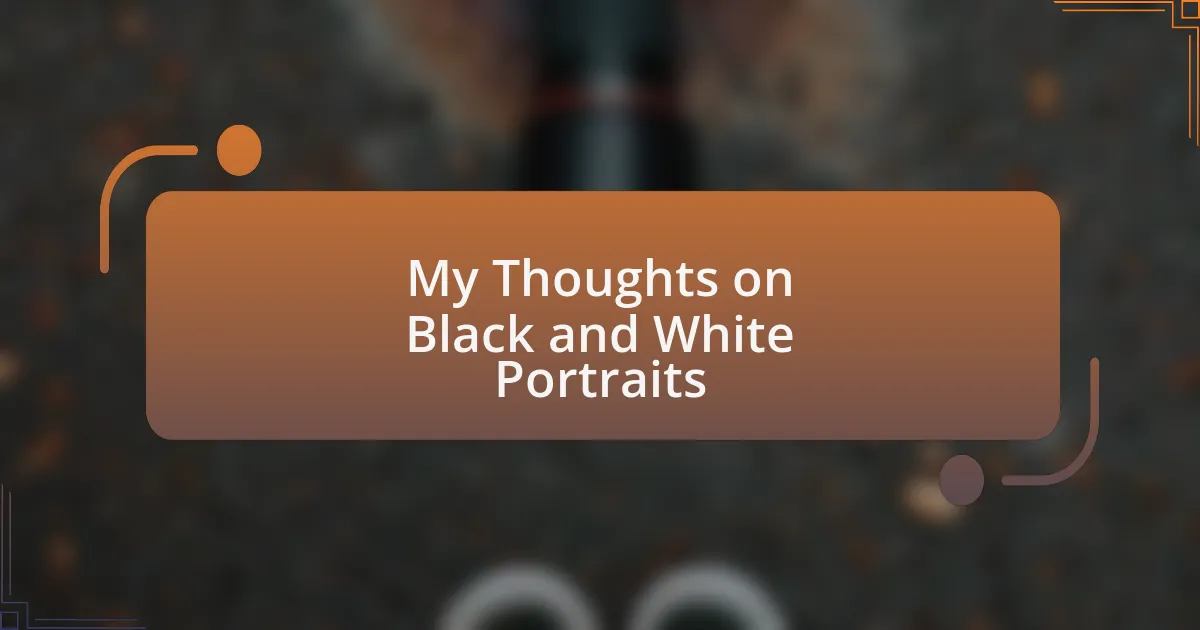Key takeaways:
- Lighting significantly impacts portrait photography, with techniques like natural light and chiaroscuro enhancing mood and emotions.
- Framing and composition, including negative space and leading lines, are essential for creating depth and engagement in portraits.
- Building a connection with subjects is crucial for capturing genuine emotions and candid moments.
- Each portrait session offers unique lessons about storytelling and the human experience through the interplay of light and shadow.
Author: Clara Ashton
Bio: Clara Ashton is a contemporary fiction author known for her evocative storytelling and richly drawn characters. With a degree in English Literature from the University of California, Berkeley, Clara combines her passion for writing with a deep understanding of narrative structure. Her debut novel, “Whispers of the Forgotten,” received critical acclaim for its poignant exploration of love and loss. Clara’s work has been featured in several literary journals, and she regularly contributes essays on the writing process. When she’s not crafting her next tale, Clara enjoys hiking in the Pacific Northwest and sipping artisanal coffee in local cafes. She currently resides in Portland, Oregon, with her two rescue dogs, Max and Bella.
Techniques for Capturing Portraits
When capturing portraits, lighting is everything. I remember my first experience using natural light. It was a late afternoon, and the soft glow wrapped around my subject, creating these amazing shadows that added depth to the image. Have you ever noticed how different angles of light can completely change the mood of a photograph?
Another technique I find essential is framing the shot. I often use negative space to draw focus to my subject. This not only emphasizes their expressions but also invites viewers to engage with the portrait more intimately. Isn’t it fascinating how composition can dictate the story a photo tells?
Additionally, I like to build a connection with my subject before pressing the shutter. There’s something magical about capturing genuine emotions—those split seconds of laughter or contemplation. How often do we rush through the process without taking a moment to connect? I’ve found that a simple conversation can reveal layers of character that translate beautifully on camera.
Choosing Lighting for Portraits
Choosing the right lighting can truly elevate a portrait. One of my memorable sessions involved experimenting with soft box lighting in the studio. The way the light diffused across my subject’s face created a gentle, flattering glow that made their features pop. Have you ever felt that sense of transformation when you adjust the light just right?
I also appreciate the dramatic effect of chiaroscuro lighting, which plays with strong contrasts between light and shadow. I recall a time when I used this technique to emphasize the rugged features of an older gentleman. The shadows fell perfectly, telling a story of his life that words couldn’t convey. Isn’t it incredible how shadows can add layers of meaning to a simple photograph?
Don’t underestimate natural light either. I have often found that the golden hour, just before sunset, offers a beautiful warmth that’s hard to replicate artificially. One evening, I shot a portrait of a young dancer outside as the sun dipped below the horizon. The light wrapped around her and highlighted her movements, making the image feel alive. Isn’t it amazing how the right moment can create such unforgettable images?
Composition Tips for Portrait Photography
One crucial aspect of portrait photography is the arrangement of elements within the frame. I remember a session where I chose to place my subject slightly off-center, following the rule of thirds. This approach not only added balance to the image but also created a sense of space around them, making the portrait feel more intimate and engaging. Have you ever noticed how a small shift in position can completely alter the story a photograph tells?
Leading lines are another powerful tool in composition. During a shoot in a bustling city street, I positioned my subject next to a series of lines created by nearby buildings. These lines naturally led the viewer’s eye towards them, setting a dynamic context and enhancing the portrait’s narrative. It made me realize how elements in our surroundings can enhance a subject’s presence. Isn’t it fascinating how the environment contributes to the emotion captured in a portrait?
Finally, don’t overlook the importance of negative space. I distinctly remember a portrait session on a vast, empty beach. By leaving ample space around my subject, I conveyed a feeling of solitude and reflection. It struck me how such simplicity could make the subject’s expressions more powerful. How do you think negative space alters the perception of a portrait?
My Personal Experience with Portraits
Every time I pick up my camera for portrait sessions, I feel a unique blend of excitement and anxiety. I vividly recall a particularly challenging shoot with a shy teenager. Getting her to feel comfortable and express herself took time, but once she loosened up, her vibrant personality shone through the lens. It made me appreciate how patience can unlock a deeper connection, don’t you think?
One of my most memorable experiences was photographing a couple celebrating their anniversary. As they shared tender moments, I felt like a fly on the wall, capturing their genuine interactions. It taught me that sometimes, the best portrait is the one where the subject isn’t posing at all, merely being themselves. How often do you think we miss those candid gems while waiting for the perfect setup?
Looking back, I realize that each portrait I’ve created has taught me something different about the human experience. I remember a session in a dimly lit café where the shadows played beautifully on my subject’s face. The moody lighting drew out emotions that were palpable, reminding me that light and shadow are not just elements of photography, but vital tools in storytelling. Isn’t it amazing how much a simple change in lighting can evoke different feelings in an image?
